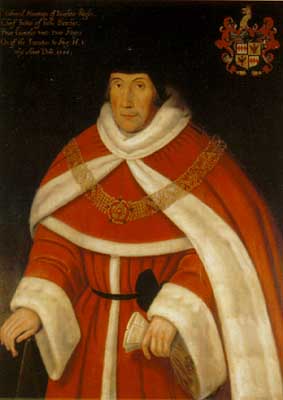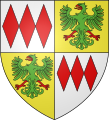Edward Montagu (judge) facts for kids
Quick facts for kids
Edward Montagu
|
|
|---|---|

Portrait of Sir Edward Montagu of Boughton (d. 1557)
|
|
| Chief Justice of the Common Pleas | |
| In office 6 November 1545 – 26 July 1553 |
|
| Appointed by | Henry VIII |
| Preceded by | Sir John Baldwin |
| Succeeded by | Sir Richard Morgan |
| Chief Justice of the King's Bench | |
| In office 22 January 1539 – 6 November 1545 |
|
| Appointed by | Henry VIII |
| Preceded by | Sir John FitzJames |
| Succeeded by | Sir Henry Montagu |
| Personal details | |
| Born | c. 1488 Brigstock, Northamptonshire |
| Died | 10 February 1557 (aged 68–69) Boughton |
| Resting place | St Mary, Weekley |
| Nationality | English |
| Spouses |
|
| Children | with Cicely:
|
| Parents | Thomas Montagu Agnes Dudley |
| Residence | Boughton House |
| Alma mater | University of Cambridge |
| Profession | Lawyer, Judge |
Sir Edward Montagu (around 1488 – 10 February 1557) was an important English lawyer and judge. He lived during the time of King Henry VIII and King Edward VI. Sir Edward held very high positions in the legal system. He was the Chief Justice of the King's Bench from 1539 to 1545. After that, he became the Chief Justice of the Common Pleas from 1545 to 1553.
Life of a Royal Judge
Sir Edward Montagu was born around 1488 in Brigstock, Northamptonshire. He was the second son of Thomas Montagu and Agnes Dudley. His family name, Montagu, was adopted by his grandfather around 1447.
He studied at the University of Cambridge. Later, he joined the Middle Temple, which is one of the four professional associations for barristers in London. He became a Serjeant-at-law in 1531, which was a very senior type of barrister. In 1537, he was made the King's Serjeant and was also knighted.
Sir Edward's career quickly advanced. In 1539, he was appointed Chief Justice of the King's Bench. This was a very powerful legal role. In 1545, he moved to a different, but still very important, position: Chief Justice of the Common Pleas. This job was considered less demanding but paid better.
He was a member of King Henry VIII's Privy Council. This meant he was a close advisor to the King. Henry VIII even chose him as one of the sixteen people to carry out his last will. Sir Edward was also made a governor for Henry's young son, Edward.
When King Edward VI tried to change who would become the next ruler in 1553, Sir Edward Montagu spoke out against it. He said it was against the law. However, a powerful nobleman, the Duke of Northumberland, threatened him. Because of this threat, Sir Edward stopped his protest. When Mary became Queen, he was put in the Tower of London. But he was able to buy his freedom and get out.
In 1528, Sir Edward bought the land of Boughton, near Kettering, Northamptonshire. He then built Boughton House there, which became the main home for his family.
Family Life
Sir Edward Montagu was married three times. His first wife was Cicely Lane. They had three sons, who sadly died young, and three daughters. His second wife was Agnes Kirkham, but they did not have any children.
His third wife was Eleanor Roper. She was the daughter of John Roper, who was also an important legal figure. With Eleanor, Sir Edward had eleven children. These included five sons and six daughters. His eldest surviving son, also named Edward Montagu (1532–1602), continued the family line. This younger Edward became the ancestor of important noble families, like the Dukes of Montagu and the Earls of Manchester.
Gallery
Death and Legacy
Sir Edward Montagu passed away at Boughton on 10 February 1557. He was buried with a grand ceremony on 5 March in the church of St Mary, Weekley. At the church, there is a special tomb with a statue of him. The statue shows him in his judge's robes. His tomb also has a motto: "Pour unge pleasoir mille dolours," which means "For every pleasure, a thousand sorrows." After his death, his widow, Eleanor, married again. She died in May 1563.
See also
- Boughton House
- Coleridge Collar





